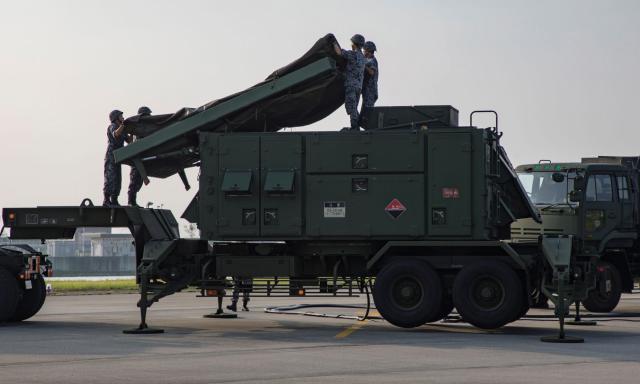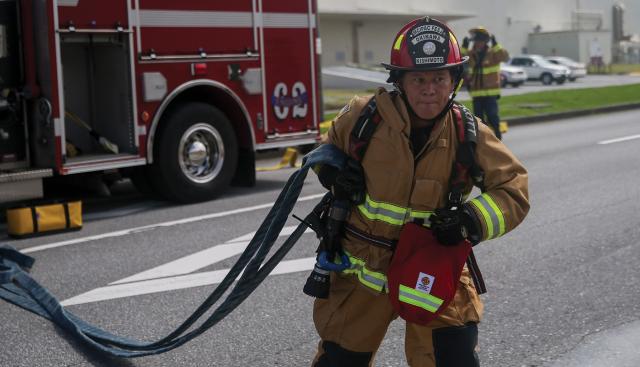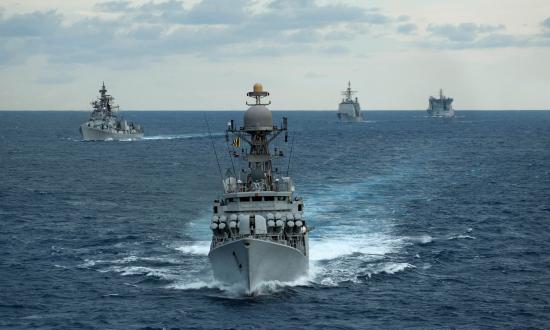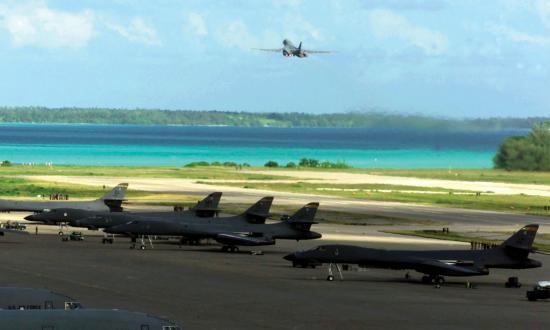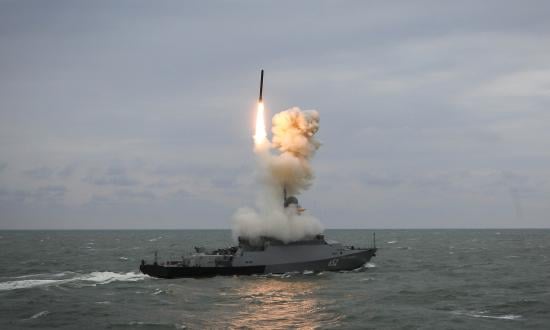“Any coach will tell you that the first step in training a fighter is developing a ‘boxer’s stance,’ the foundational posture from which all offensive and defensive movements flow.” —General Joseph F. Dunford Jr. “Maintaining a Boxer’s Stance,” Joint Force Quarterly, June 2017
Since the end of the Cold War, the U.S. military’s unfettered ability to project power has afforded a luxury of prioritizing offensive striking systems over the development of defensive operating concepts, protection capabilities, and needed investments in installations. Today, however, particularly in the Indo-Pacific, the quantity, immediacy, and sophistication of threats arrayed against the joint force necessitate a new way of thinking.
Potential adversaries are pursuing capabilities designed to thwart U.S. power projection; consequently, naval expeditionary forces are reassessing long-held assumptions about how to most effectively operate in the Indo-Pacific theater. As this process plays out, the Navy–Marine Corps team must avoid placing a disproportionate emphasis on sensors, fires, and maneuver at the expense of the key maritime terrain from which it operates, sustains, and stands shoulder-to-shoulder with U.S. allies: its forward installations. These bases and stations afford a critical positional advantage, underpin the joint force’s ability to compete, extend its operational reach, and by their very nature, enable sea control, sea denial, and deterrence.
The Indo-Pacific Context
Three factors are driving a renewed focus on Indo-Pacific installations. First, the region is the top priority in the National Defense Strategy, and some simple facts explain why: The Indo-Pacific contains half of the world’s population (3.5 billion people); four of the world’s top six economies (U.S., China, Japan, and India); five of its nine nuclear powers (United States, China, North Korea, India, and Russia); and six U.S. treaty allies (Japan, Republic of Korea, Philippines, Thailand, Australia, and New Zealand). It also is a maritime theater containing the world’s busiest international sea-lanes and nine of its ten largest seaports.
Amid and in overwatch of this highly prized real estate, U.S. installations stand as littoral bulwarks, situated where all warfighting domains—sea, air, land, space, and cyberspace—intersect and collide. They underwrite the nation’s maritime strength and are the most tangible expression of U.S. commitments to forward deterrence and defense in the region. Together, they constitute a “shield of the Indo-Pacific,” providing a critical 6,000-mile head start in protecting the U.S. homeland, advancing national interests, and extending the reach, versatility, and endurance of naval expeditionary forces.
Second, the Indo-Pacific is a nuclear neighborhood in which deterrence is paramount. Everything naval expeditionary forces do—from assuring allies to deterring adversaries, and from competing to crisis response—occurs within a nuclear context. Against this backdrop, China, Russia, and North Korea seek to exploit perceived gaps in the U.S. alliance architecture by leveraging their increasingly capable maritime, long-range missile, strike, cyber, and electronic warfare capabilities to saber-rattle, mask other malign activities, and intimidate smaller neighbors. Developing offsets to these capabilities certainly is prudent; however, the ability to serve as the Indo-Pacific’s stand-in force requires increased attention to the physical locations—the forward installations—from which naval expeditionary forces will marshal, aggregate, rehearse, project, command and control, and sustain the force in any regional crisis or contingency.
Third, there is a growing realization that success in the Indo-Pacific requires sustained, predictable, and regionally tailored resourcing. While every installation wrestles with the challenges of weather, espionage, terrorism, cyber intrusion, and misinformation, Indo-Pacific installations are geographically remote and function under conditions of threat immediacy and hyper-competition. Adversary capabilities—including precision strike, nonkinetic weapons, and sophisticated use of competitive coercion techniques—exacerbate the region’s long lines of resupply and communications, raising the stakes for commanders and all those who live and work on the installations. Accordingly, cookie-cutter resourcing solutions appropriate for stateside garrisons do not comport with the all-domain, multifunctional threats levied against Indo-Pacific installations. “Mirrored” tables of organization, equipment, manning, investment levels, and thinking will not work in this theater.
A New Framework for Resiliency
Commandant of the Marine Corps General David Berger acknowledges the imperative to think anew about installations, recently writing, “Our forward bases and infrastructure—including large runways, deep water ports, and associated large and exquisite platforms resident at our forward-deployed locations—within adversary weapons engagement zones are vulnerable targets.”1 Yet, abandoning forward installations is not realistic. What is needed is new thinking about how to:
- Raise the costs of launching an attack against them
- Reduce operational dependence on them
- Improve their resilience across dimensions and domains to better operate, and if necessary fight, from them
While naval doctrine does not describe “resiliency,” it can be thought of as the capability to protect and project offensive combat power following an enemy attack or disaster. New thinking about terms such as “survivability” and “protection” enable discussion of a new four-part “hardening framework” to identify seams, make improvements, weigh needed investments, and mitigate risks.
Tactical hardening is those material and/or manpower-intensive solutions designed to protect personnel and infrastructure from the effects of kinetic and nonkinetic weapons. It includes fortifications, entry control, blast protection, revetments, chemical protection, counter–unmanned aerial systems capabilities, countermine capabilities, security personnel, rapid runway repair materials and equipment, and system redundancy. Admittedly, tactically hardening installations can be expensive and, depending on the threat, ultimately insufficient, especially in a nuclear conflict. That said, some form of tactical hardening always will be required for select assets and key infrastructure.
Operational hardening is achieved through force dispersal and distribution, challenging an adversary’s ability to strike lucrative targets by removing them from a fixed geographic area while still enabling friendly commanders to achieve the desired end-state. Establishing an expeditionary advanced base early in a crisis or campaign is an example of operational hardening, as doing so would disperse combat power, complicate adversary targeting, and expand future options for the joint force commander. Practical models of operational hardening include cooperative security locations (CSLs) possessing fuel, apron space, runways, repair materials, and prepositioned ordnance to support combat operations.
Operational hardening generally is more cost-effective and operationally attractive than tactical hardening. For example, constructing revetments at an air base to protect aircraft from rocket-propelled grenades and vehicle-borne improvised explosives could cost upward of $35 million. Conversely, improving an auxiliary landing field’s capabilities to fuel and arm aircraft in a rudimentary fashion could cost less than $5 million and is well within the capabilities of naval expeditionary construction forces. The former option invites flying units to operate from a fixed site under a mirage of well-financed but ultimately insufficient protection, while the latter and more affordable option provides combat aviation a dispersal option at roughly 10 percent of the cost.
Strategic hardening further complicates adversary targeting decisions through formal treaty alliances, military and civilian co-use activities, and sociocultural significance. An example of a strategically hardened facility is a combined air base that houses both U.S. and host-nation flying units. This same air base might also share a runway with an international airport operating commercial flights for host-nation citizens and transiting third-country nationals.2 Together, these factors could change the calculus for adversaries contemplating striking such a base. This type of combined or co-use installation also fosters both interoperability and information-sharing with a partnered or allied force and thereby gains highly desirable efficiencies in base defense, logistical support, and supply chain management.
Political hardening is achieved through formal alliances or agreements. The United States enjoys some of its strongest treaty-based alliances in the Indo-Pacific. The durability of these alliances is founded on an unshakable conviction that the United States remains committed to international stability, to collective security, and to prevailing should deterrence fail. However, that confidence would be badly shaken if forward installations were ever shown to be less than resilient in the face of enemy action. Modernizing alliances and improving our force posture are important and necessary elements of political hardening.
The Way Ahead
Looking to the future, there is reason for optimism, as an awakening of sorts has occurred inside the joint force, in Congress, and among U.S. allies in the Indo-Pacific. First, naval expeditionary forces are getting serious about developing defensive operating concepts and capabilities and, within the context of sea control and denial-enabled deterrence, are shifting to focus on protecting combat power, not solely projecting it. Exercises are increasingly realistic and now reflect the critical positional advantage and irreplaceable functions that Indo-Pacific installations provide. These exercises are beginning to incorporate, rehearse, and assess events such as kinetic and cyber strikes, electronic and chemical attacks, civilian labor challenges, noncombatant evacuations, disruptions to supply chains, and the prioritization of scarce resources on and among U.S. installations. In the past, scenario developers tended to “wish away” these kinds of dilemmas based on a belief that host-nation participants would object. Nothing could be further from the truth. Allies and partners recognize the gravity of the situation in the region and are poised and ready to collaborate.
Second, both the House and Senate have prioritized Indo-Pacific posture and region-specific resourcing in their respective versions of the Fiscal Year 2021 National Defense Authorization Act. The chairman and ranking member of the Senate Armed Services Committee both embrace the essential role that overseas operating locations provide, recently noting:
Posture and logistics remain serious weak spots for credible American deterrence in the Indo-Pacific. . . . [I]t doesn’t matter how many F-35s the military buys if very few are stationed in the region, their primary bases have little defense against Chinese missiles, they don’t have secondary airfields to operate from, [or] they can’t access prepositioned stocks of fuel and munitions.3
Third, U.S. forces are working closer than ever with allies on the defense of forward installations and, in doing so, are achieving greater levels of interoperability, collaboration, and cohesion. Installations are excellent vehicles to drive information sharing, foster readiness, and build shared confidence, thus blunting adversary efforts to fracture and erode U.S. alliances. Allied-nation vessels and aircraft operate from shared naval installations, a model ripe for application by ground forces. Bilateral and multilateral exercises have been modernized to focus on generating combat power during times of crisis, and it is now common to see other nations’ service members not only visiting, but also actively planning operations on board U.S. installations. U.S. military families live, shop, and thrive in their host nations and form lasting friendships with their citizens.
Perhaps most important, nearly half the workforce required to operate Indo-Pacific installations are local national employees. These experienced professionals and skilled craftsmen underpin a wide array of essential combat support functions: They fuel equipment, drive and repair vehicles, feed the force, maintain utilities infrastructure, and respond to emergencies, thus creating very real combat power. Many choose to remain in service for decades because they embrace the importance of their roles and because their American coworkers embody the Navy and Marine Corps ethos and core values. We can never forget that without our allies, we have zero strategic position in the Indo-Pacific; and without projecting our ethos and core values daily, we place our alliances at risk.
To Remain Most Ready
The Washington Naval Treaties of 1922 infamously contained a “non-fortification clause” prohibiting its signatories—the United States, Great Britain, and Japan—from constructing hardened facilities in the Pacific. The doctrinally myopic or those of limited imagination may have been stymied by this restriction, but for visionaries such as Commander Chester Nimitz and Lieutenant Colonel Earl “Pete” Ellis, it fueled a spirit of determined innovation. Along with many others, they spearheaded transformative solutions such as seagoing dry docks, at-sea oil replenishment, longer-legged surface ships, and a new role for the Marine Corps in War Plan Orange centered on the seizure and defense of advanced naval bases.4 Their bold thinking changed the way the Navy-Marine Corps team thought about and operated in the western Pacific. Today’s joint force must similarly change the way it views its Pacific posture and the installations from which it flies, sails, operates, sustains, competes, deters, and, when necessary, fights.
More than 75 years have passed since the Greatest Generation’s sailors and Marines fought their way across the Pacific to seize the positional advantage the nation enjoys today. Their valor and sacrifices and enduring national interests are a call to action. Investing in Indo-Pacific installation resilience across dimensions and domains will ensure naval expeditionary forces have the wherewithal and suite of capabilities necessary to “compete today, fight now” and remain “most ready when the nation is least ready.”
1. GEN David H. Berger, USMC, “Together We Must Design the Future Force,” U.S. Naval Institute Proceedings 145, no. 11 (November 2019).
2. The authors acknowledge the prohibition on mixing civilian and military personnel or objects to purposely mask or protect distinctly military activities. The theoretical example of a co-use airfield does not intend to circumvent this prohibition; it merely illustrates that co-use airfields carry a secondary, unintentional benefit of deterring attack. Rather, the authors propose an expansion of co-use facilities. Examples already in existence include Hickam AFB, MCAS Iwakuni, and MCAS Yuma.
3. Senators Jim Inhofe and Jack Reed, “The Pacific Deterrence Initiative: Peace through Strength in the Indo-Pacific,” War on the Rocks, 28 May 2020, https://warontherocks.com/2020/05/the-pacific-deterrence-initiative-peace-through-strength-in-the-indo-pacific/.
4. Michael J. Green, By More Than Providence: Grand Strategy and American Power in the Asia-Pacific Since 1783 (New York: Columbia University Press, 2017), 141.
5. GEN David H. Berger, USMC, Commandant’s Planning Guidance, Headquarters, U.S. Marine Corps (July 2019), 5.




